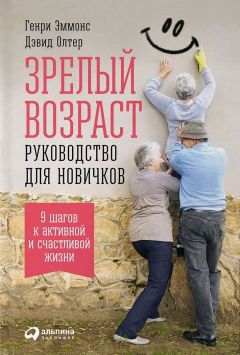Генри Эммонс - Зрелый возраст

Помощь проекту
Зрелый возраст читать книгу онлайн
14. G. Mark et al., “The Cost of Interrupted Work: More Speed and Stress,” Proceedings of the SIGCHI Conference on Human Factors in Computing Systems (2008): 107-10.
15. C. Woolston, “Multitasking and Stress,” HealthDay (Mar. 2013): http://cosumer. healthday.com/encyclopedia/article.asp? AID= 646052.
16. Quoted by C. Rosen, “The Myth of Multitasking,” The New Atlantis 20 (Spring 2008): 105-10.
17. E. Ophir et al., “Cognitive Control in Media Multitaskers,” Proceedings of the National Academy of Sciences of the United States of America 106, no. 37 (Sept. 15,2009): 15583-87.
18. P. Grossman et al., “Mindfulness-Based Stress Reduction and Health Benefits: A Meta-Analy sis,” Journal of Psychosomatic Research 57, no. 1 (2004): 35-43.
19. N.E. Morone et al., “Mindfulness Meditation for the Treatment of Chronic Low Back Pain in Older Adults: A Randomized Controlled Pilot Study,” Pain 134 (2008) : 310-19.
20. H. Cramer et al., “Mindfulness-Based Stress Reduction for Breast Cancer: A Systematic Review and Meta-Analysis,” Current Oncology 19, no. 5 (2012): 343-52.
21. R.J. Davidson et al., “Alterations in Brain and Immune Function Produced by Mindfulness Meditation,” Psychosomatic Medicine 65 (2003): 564-70.
22. J.D. Creswell et al., “Mindfulness Meditation Training Effects on CD4+ T Lymphocytes in HIV-1 Infected Adults: A Small Randomized Controlled Trial,” Brain, Behavior, and Immunity 23, no. 2 (Feb. 2009): 184-88.
23. M. Killingsworth, “Does Mind-Wandering Make You Unhappy?,” Greater Good, July 16, 2013, http://greatergood.berkeley.edu/article/item/does mind wandering make you unhappy.
24. W. Hasenkamp et al., “Mind Wandering and Attention during Focused Meditation: A Fine-Grained Temporal Analysis of Fluctuating Cognitive States,” Neuro-Image 59 (2012): 750-60.
25. W. Hasenkamp, “How to Focus a Wandering Mind,” Daily Good, July 17, 2013. http://greatergood.berkeley.edu/article/item/how to focus a wandering mind.
26. F. Zeidan et al., “Mindfulness Meditation Improves Cognition: Evidence of Brief Mental Training,” Consciousness and Cognition, 19, no. 2 (June 2010): 597-605.
27. L. Bylsma et al., “A Meta-analysis of Emotional Reactivity in Major Depressive Disorder,” Clinical Psychology Review, 28, no. 4 (Apr. 2008): 676-91.
28. J. Lutz et al., “Mindfulness and Emotion Regulation — an fMRI Study,” Social Cognitive and Affective Neuroscience, doi:10.1093/scan/nst043 (first published online Apr. 5,2013).
29. E. Luders et al., “The Underlying Anatomical Correlates of Long-Term Meditation: Larger Hippocampal and Frontal Volumes of Gray Matter,” Neuroimage, 45 (2009) : 672-78.
30. Е. Luders, quoted by M. Wheeler in “How to Build a Bigger Brain,” UCLA News, May 12, 2009, http://newsroom.ucla.edu/portal/ucla/PRN-how-to-build-a-bigger-brain-91273.aspx.
31. J. Johnson, H. Emmons, et al., “Resilience Training for Depressed and Stressed Healthcare Professionals,” Jan. 2014 (submitted for publication).
4. Мозг любит движение: шаг первый32. В. Winter et al., “High-Impact Running Improves Learning,” Neurobiology of Learning and Memory 87, no. 4 (2007): 597-609.
33. J.S. Snyder et al., “The Effects of Exercise and Stress on the Survival and Maturation of Adult-Generated Granule Cells,” Hippocampus, Epub ahead of print (Jan. 20.2009): 1-9, doi:10.1002/hipo.20552.
34. S. Vaynman and F. Gomez-Pinilla, “License to Run: Exercise Impacts Functional Plasticity in the Intact and Injured Central Nervous System by Using Neurotrophins," Neurorehabilitation and Neural Repair 19, no. 4 (2005): 283-95.
35. http://www.cdc.gov/physicalactivity/everyone/guidelines/adults.html.
36. Center for Disease Control and Prevention, “One in Five Adults Meets Overall Physical Activity Guidelines,” Press Release, May 2,2013, http://www.cdc.gov/ media/releases/2013/p0502-physical-activity.html.
37. N. Mischel et al., “Physical (In)activity-Dependent Structural Plasticity in Bulbospinal Catecholaminergic Neurons of Rat Rostral Ventrolateral Medulla,” Journal of Comparative Neurology 522, no. 3 (Feb. 15,2014): 499-513.
38. A. Gow et al., “Neuroprotective Lifestyles and the Aging Brain: Activity, Atrophy, and White Matter Integrity,” Neurology 79, no. 17 (Oct. 2012): 1802-8.
39. K.I. Erickson et al., “Exercise Training Increases Size of Hippocampus and Improves Memory,” Proceedings of the National Academy of Sciences 108, no. 7 (Feb. 15,2011): 3017-22.
40. J. Mota-Pereira, J. Silverio, et al., “Moderate Exercise Improves Depression Parameters in Treatment-Resistant Patients with Major Depressive Disorder,” Journal of Psychiatric Research 45, no. 8 (Aug. 2011).
41. J.B. Bartholomew et al., “Effects of Acute Exercise on Mood and Well-Being in Patients with Major Depressive Disorder," Medicine and Science in Sports and Exercise 37, no. 12 (2005): 2032-37.
42. Alzheimer’s Association, “2013 Alzheimer’s Disease Facts and Figures,” http:// www.alz.org/downloads/facts figures 2013.pdf, accessed Jan. 25,2014.
43. G. Small et al., “Healthy Behavior and Memory Self-Reports in Young, Middle-Aged, and Older Adults,” International Psychogeriatrics 25, no. 6 (June 2013): 981-89.
44. R. Carrington et al., “Cardiorespiratory Fitness and Accelerated Cognitive Decline with Aging,” Journals of Gerontology, doi:10.1093/gerona/gltl44 (first published online Nov. 5,2013).
45. D. Head et al., “Exercise Engagement as a Moderator of the Effects of APOE Genotype on Amyloid Deposition.” Archives of Neurology 69, no. 5 (2012): 636-43.
46. K. Liang et al., “Exercise and Alzheimer’s Disease Biomarkers in Cognitively Normal Older Adults,” Annals of Neurology 68, no. 3 (2010): 311-18.
47. E.J. Huang and L.F. Reichart, “Neurotrophins: Roles in Neuronal Development and Function," Annual Review of Neuroscience 24 (Mar. 2001): 677-736.
48. X. Jiang et al., “BDNF Variation and Mood Disorders: A Novel Functional Promoter Polymorphism and Val66Met Are Associated with Anxiety But Have Opposing Effects,” Neuropsychopharmacology 30 (2005): 1353-61.
49. H.S. Phillips et al., “BDNF mRNA Is Decreased in the Hippocampus of Individuals with Alzheimer’s Disease,” Neuron 7, no. 5 (Nov. 1991): 695-702.
50. D.W. Howells et al., “Reduced BDNF mRNA Expression in the Parkinson’s Disease Substantia Nigra,” Experimental Neurology 166, no. 1 (Nov. 2000): 127-35.
51. J.L. Wamer-Schmidt and R.S. Duman, “Hippocampal Neurogenesis: Opposing Effects of Stress and Antidepressant Treatment,” Hippocampus 16, no. 3 (2006): 239-49.
52. H. van Praag et al., “Running Increases Cell Proliferation and Neurogenesis in the Adult Mouse Dentate Gyrus," Nature Neuroscience 2 (1999): 266-70.
53. A.A. Garza et al., “Exercise, Antidepressant Treatment, and BDNF mRNA Expression in the Aging Brain,” Pharmacology, Biochemistry and Behavior 77, no. 2 (2004): 209-20.
54. B. Eadie et al., “Voluntary Exercise Increases Neurogenic Activity in the Dentate Gyrus of the Adult Mammalian Brain: Fact of Fiction?” poster presented at the Annual Meeting of the Society for Neuroscience, 2004.
55. L. Byberg et al., “Total Mortality after Changes in Leisure-Time Physical Activity in 50-Year-Old Men: 35-Year Follow-Up of Population-Based Cohort,” British MedicalJournal 338 (2009): b668, doi:10.1136/bmj.b688.
56.1. Barnett et al., “Changes in Household, Transport and Recreational Physical Activity and Television Viewing Time across the Transition to Retirement: Longitudinal Evidence from the EPIC-Norfolk Cohort,” Journal of Epidemiology and Community Health”, doi:10.1136/jech-2013-203225.
57. B. Liebman, “Chair Today, Gone Tomorrow,” interview with James Levine, MD, Nutrition Action Healthletter 35, no. 3 (Apr. 2008): 3-6.
58. B. Ainsworth, W. Haskell, et al., “2011 Compendium of Physical Activities: A Second Update of Codes and MET Values,” Medicine and Science in Sports and Exercise 43, no. 8:1575-81 (2011).
59. Heydari et al., “The Effect of High-Intensity Intermittent Exercise on Body Composition of Overweight Young Males,” Journal of Obesity 2012, article ID480467 (2012), http://dx.doi.org/10.1155/2012/480467.
60. J. King, “A Comparison of the Effects of Interval Training vs. Continuous Training on Weight Loss and Body Composition in Obese Pre-Menopausal Women,” M.A. thesis, East Tennessee State University.
61. P. Wahl, “Hormonal and Metabolic Responses to High Intensity Interval Training," Journal of Sports Medicine and Doping Studies 3, no. 1 (2013): el32, doi:10.4172/2161-0673.1000el32.
62. J. Gillen et al., “Acute High-Intensity Interval Exercise Reduces the Postprandial Glucose Response and Prevalence of Hyperglycaemia in Patients with Type 2 Diabetes,” Diabetes Obesity and Metabolism 14, vol. 6 (June 2012): 575-77.
63. Heydari et al., “The Effect of High-Intensity Intermittent Exercise on Body Composition of Overweight Young Males,” Journal of Obesity (2012), article ID480467,8 pp. http://dx.doi.org/10.1155/2012/480467.
5. Мозг нуждается в отдыхе: шаг второй64. http://www.cdc.gov/features/dssleep.
65. National Institutes of Health, “National Institutes of Health State-of-the-Science Conference Statement on Manifestations and Management of Chronic Insomnia in Adults," Sleep 28 (June 2005): 1049-57.
66. M. Wang, S. Wang, and P. Tsai, “Cognitive Behavioral Therapy for Primary Insomnia: A Systematic Review,” Journal of Advances in Nursing 50 (2005): 553-64.
67. www.sleepfoundation.org/article/sleep-related-problems/sleep-aids-and-insomnia.
68. www.sleepfoundation.org/article/sleep-topics/aging-and-sleep.
69. B. Carey, “Sleep Therapy Seen as an Aid for Depression,” The New York Times. Nov. 18,2013, accessed Feb. 20,2014.
70. C. Carney et al., “The Relation between Insomnia Symptoms, Mood, and Rumination about Insomnia Symptoms,” Journal of Clinical Sleep Medicine 9, no. 6 (June 15.2013): 567-75.
71. J. Suttie, “Why You Should Sleep Your Way to the Top,” Greater Good, Dec. 1, 2013, accessed Feb. 20, 2014. http://greatergood.berkeley.edu/article/item/ why_sleep your way top.
72. S. Brand et al., “Adolescents with Greater Mental Toughness Show Higher Sleep Efficiency, More Deep Sleep and Fewer Awakenings after Sleep Onset," Journal of Adolescent Health 54, no. 1 (Jan. 2014): 109-13.
73. J. Suttie, “Why You Should Sleep Your Way to the Top,” http://greatergood. berkeley.edu/article/item why sleep your way top.
74. B. Mander et al., “Prefrontal Atrophy, Disrupted NREM Slow Waves and Impaired Hippocampal-Dependent Memory in Aging,” Nature Neuroscience 16, (2013): 357-64.
75. J. Suttie, “Why You Should Sleep Your Way to the Top.”
76. A. Prather et al., “Gender Differences in the Prospective Associations of Self-Reported Sleep Quality with Biomarkers of Systemic Inflammation and Coagulation: Findings from the Heart and Soul Study,” Journal of Psychiatric Research 47, no. 9 (Sept. 2013): 1228-35, doi:10.1016/j.jpsychires.2013.05.004. Epub 2013 Jun 5.
77. J. Broussard et al., “Impaired Insulin Signaling in Human Adipocytes after Experimental Sleep Restriction,” Annals of Internal Medicine 157 (2012): 549-57.
78. Y. Liu et al., “Association between Perceived Insufficient Sleep, Frequent Mental Distress, Obesity and Chronic Diseases among US Adults, 2009 Behavioral Risk Factor Surveillance System,” BMC Public Health 13 (2013): 84, no. 1, doi:10.1186/1471-2458-13-84.
79. A. Jagannath et al., “Sleep and Circadian Rhythm Disruption in Neuropsychiatric Illness.” Current Opinion in Neurobiology 23, no 5 (Oct. 2013): 888-94.
80. F. Benedetti and M. Terman, “Much Ado About... A Moody Clock," Biological Psychiatry 74, no. 4 (Aug. 15, 2013): 236-37.
81. C. Moller-Levet et al., “Effects of Insufficient Sleep on Circadian Rhythmicity and Expression Amplitude of the Human Blood Transcriptome,” Proceedings of the National Academy of Sciences 110, no. 12 (Mar. 19,2013): 1132-41.
82. K. Obayashi et al., “Exposure to Light at Night and Risk of Depression in the Elderly,” Journal of Affective Disorders, article in press.
83. R. Lieverse et al., “Bright Light Treatment in Elderly Patients with Nonseasonal Major Depressive Disorder: A Randomized Placebo-Controlled Trial,” Archives of General Psychiatry 68, no. 1 (2011): 61-70, doi:101001/ archgenpsychiatry.2010.183.
84. A. Wirzjustice et al., “Chronotherapeutics (Light and Wake Therapy) in Affective Disorders,” Psychological Medicine 35 (2005): 939944, doi:10.1017/ S003329170500437X.
85. J. Gooley et al., “Exposure to Room Light before Bedtime Suppresses Melatonin Onset and Shortens Melatonin Duration in Humans,” Journal of Clinical Endocrinology and Metabolism 96, no. 3 (Mar. 2011): E463-472.
86. L. Xie et al., “Sleep Drives Metabolite Clearance from the Adult Brain,” Science 342, no. 6156 (Oct. 18.2013): 373-77.
87. B. Luscombe, “Your Brain Cells Shrink While You Sleep (And That’s a Good Thing)," Time, Oct. 17, 2013, accessed Feb. 23,2014, http://healthland.time. com/2013/10/17/your-brain-cells-shrink-while-you-sleep-and-thats-a-good-thing/#ixzz2uBRM9BAD.

























